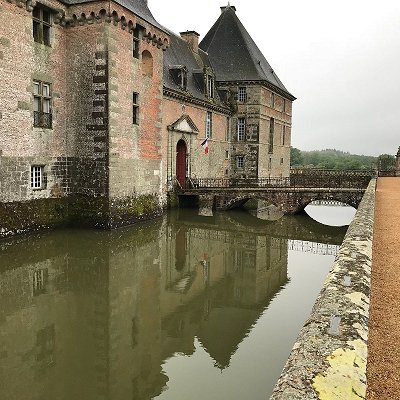
Like us on Facebook
PLACE NAMES


 
|
|
Carrouges
|

|
|
Carrouges is a commune in the Orne department in north-western France.
The inhabitants are known as Carrougiens and Carrougiennes. The town is home to a castle (Château de Carrouges), built in the 14th century by Jean de Carrouges and restored after the Hundred Years War.
In the Middle Ages, Carrouges was part of the deanery of Asnebec. In 1490, under King Charles VIII, Jean de Blosset, Lord of Carrouges and grand marshal of Normandy, founded on his land, with its castle, a college (dedicated to Our Lady of Good Comfort) six canons payments the appointment of the lord who was also the collateur profits. These payments were estimated in 1698 to 200 pounds in Memory of the General Alençon by the intendant, M. de Pommereuil. It is also stated in 1698, that a court called "breadbasket tax" (related to gabelle paid on the salt) was located in Carrouges.
In the 16th century, the family of Le Veneur de TilliÈres came into possession of the château. It was extended several times until the 17th century, with notable additions including a gatehouse, the western bastion, and the grand apartments. The interior was remodelled in the 18th century, when the music room was built. The last Le Veneur sold the château to the French state, and from 1944 it was restored. It is now managed by the Centre des monuments nationaux and is open to the public.
The Château is rectangular in plan, surrounded by a moat. The central courtyard opens on to a terrace to the south-west. Although elements survive from the 15th and 16th centuries, the majority of the architecture is in the Henri IV and Louis XIII styles. The frontage is constructed of red brick and granite, the roofs are of blue slates. The château also has a keep of the 14th century, two storeys high and topped by machicolations.
The 16th century châtelet, or gatehouse, comprises four circular turrets, and was probably built by Jean Le Veneur. It is constructed of red and black bricks.
The ground floor of the east wing contains the service areas, while the first floor contains the state apartments. The apartments are decorated in Renaissance and traditional styles. The "Louis XI room" contains a bed with fabric imitating Hungarian point stitch. The chimney breast in the antichambre d'honneur is decorated with a hunting scene. The dining room is furnished with a granite chimney piece, with Corinthian capitals. Furniture is of the Louis XIV and Restoration styles. The Salon des Portraits contains portraits of the lords and owners of Carrouges. The Grand Salon occupies one corner of the building, the straw-coloured woodwork dates from the end of the 17th and the beginning of the 18th century. The main staircase, with its pink brick vaults, rests on four piles laid out in a square.
The park and gardens extend to 10 hectares (25 acres), and are undergoing restoration.
During the French Revolution of 1789, the town was called "Carrouges-la-Montagne". In August 1944, occupied by German forces, the city was liberated by the troops of the 3rd U.S. armored division, following the deeds of Mayor Geslain, who after being released from the German soldiers who had arrested him, indicated the positions of the Germans to the Americans.
 Feel free to Email me any additions or corrections Feel free to Email me any additions or corrections
LINKS AVAILABLE TO YOUR SITE
| | |





